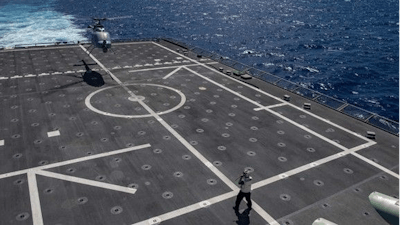
Northrop Grumman’s MQ-8C Fire Scout, the U.S. Navy’s autonomous, runway-independent helicopter system, made its second operational deployment, and first deployment to the Indo-Pacific Area of Responsibility aboard USS Jackson (LCS-6) providing military commanders greater maritime intelligence, surveillance, reconnaissance and targeting (ISR&T) capability.
MQ-8C Fire Scout continues to deploy on littoral combat ships with future deployments planned on Constellation-class guided-missile frigates and operations from shore sites under the Expeditionary Advance Base Operations concept, including potential logistics cargo role. Other potential future roles for the MQ-8C include mine countermeasures and anti-submarine warfare.
In addition to providing critical decision-making, MQ-8C Fire Scout is supporting advanced capabilities including demonstrating manned-unmanned teaming (MUMT), enabling sensor information sharing across a distributed force, further increasing survivability, reducing risk to and burden on manned aircraft, and enhancing weapons capacity. Fire Scout is furthering the successful integration of unmanned platforms and manned assets at sea.
With Fire Scout’s ability to operate at extended ranges required for future warfighting activities, the autonomous helicopter system provides responsive, reliable, and real-time surveillance capabilities and operates from both air-capable ships and developed or austere landing zones.






















